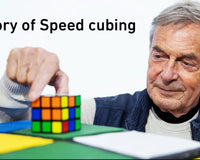What are Barriers?
Speedcubing is a sport that requires rigorous practice and immense dedication to improve at. A combination of both the body and mind working harmoniously to solve puzzles as quickly as possible while being efficient, it takes a lot to get better and make progress over time. Hence, as logical beings, we tend to set short-term goals and targets for times to achieve within which we attempt to solve the puzzle.

These targets are called barriers and refer to set amounts of time within which the puzzle is attempted to be solved. For example, saying that you want to be sub-30 on the 3x3 Rubik’s Cube means that you are trying to solve it within 30 seconds on average, a ‘barrier’ that takes most people some time to overcome.
Types of Barriers
There are multiple barriers that come into play as with any activity that requires both physical and mental participation. The involvement of the human brain automatically engenders a response in the subconscious to desire staged improvement. This means that your mind is going to create the picture in your head of what it must be to solve the puzzle that you’re on within that barrier and try to manifest it in the form of practice.
This brings us to the discussion on the types of barriers. There are probably many types that can’t even be categorized but for now, we can say there are two main types:
- Back-end: These commonly refer to the ability to look ahead, predict and control your thoughts during a solve to the extent required to surpass the time that you are aiming to beat.
- Front-end: These refer to your hands and/or arms as they are involved in the solve. In order to beat your time barriers, you will need to develop finger tricks and turning accuracy to match that. This creates a physical barrier to improvement and is required to be actively worked on.
Why They Are Relevant
This classification highlights the main relevance of barriers, which all boil down to what I like to call ‘temporal’ barriers. Temporal refers to ‘time’ and so, this is to say that every barrier is playing a role to ultimately help you beat a barrier of time (say sub-x). This is what makes barriers so real and hard to beat.

The idea that barriers evolved over the years towards shorter spans of time shows their relevance in cubing. This is because of how people such as Max Park and Tymon Kolasinski keep pushing the limits of cubing. They have reached stages of fine-tuning with regard to their physical as well as mental capability such that they have multiple world records and other laurels to their names.
Do They Actually Exist?
This is a hotly debated topic in the cubing community, about whether barriers actually even exist or not. I guess the only answer is that they do if you choose to believe that they do, and whether or not believing that they do exist works out for you in your journey of improvement.
Personally, I believe that barriers do exist, but aren’t necessarily the most important thing to focus on as you work on getting faster. In fact, they may create unrealistic standards of improvement or speed, and you’re probably better off working on tangible things such as your finger tricks, the efficiency of execution, and algorithmic vocabulary.
They Actually May Not…
However, there are many cubers that believe that barriers don’t really exist and that improvement doesn’t rely on their active involvement in your progress. This view is also extremely valid since it can really help some, if not a lot, of people to work on things that they can instead of worrying about getting faster. Also, this encourages slow solving, which is a great practice technique of its own that can pay huge dividends without even considering the time taken to solve the puzzle.
Do They Matter?
Yes, barriers, whether or not they exist to you, matter in terms of being good pedestals of comparison. They are also good as long-term targets that can be sought to be achieved. In addition to this, breaking one of these barriers can result in boosts of dopamine, serotonin, and other hormones that make your brain feel amazing! This can be a huge source of motivation for a lot of cubers, making them extremely relevant.

Conclusion
Thus, to conclude, it’s safe to say that barriers are mental within the mind of the cuber, but literal to the big picture. They may just be intangible things created by our brains, but they are still quite useful and impactful as a whole. So, it’s up to you to choose whether or not you believe in them. What are you waiting for? Pick a side and see if it works for you, and then head on in your journey toward becoming the best!
About Author

Akshaansh Chilakapati
Akshaansh Chilakapati is a speedcuber from Hyderabad who specializes in big cubes. He started cubing when he was 15 and has 5 years of cubing experience. He loves to play sports, and music and has a passion for astrophysics. He has attended 20 competitions and won a total of 64 podiums with 16 gold medals. He is also ranked 13th in India for the overall Sum of Ranks (SOR).






























